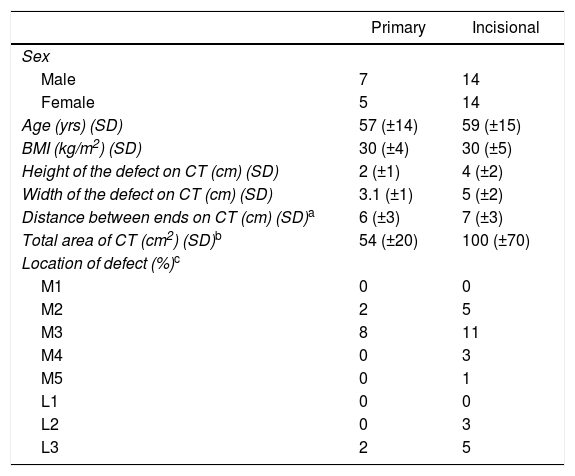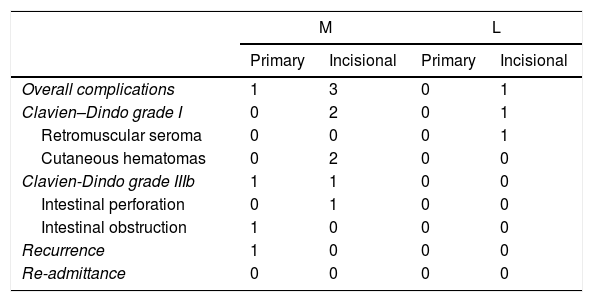Since the first laparoscopic incisional hernia repair, several minimally invasive procedures have been developed in abdominal wall repair. In 2017, the extended totally extraperitoneal (eTEP) approach for abdominal wall repair was published. We present the results from eTEP implementation at two medical centers by one surgeon.
MethodsProspective descriptive study of the implementation of the eTEP approach, with transversus abdominis release (TAR) when needed. The surgical technique was initiated by accessing the space between the rectus abdominis muscle and posterior rectus sheath, connecting this space with the fatty preperitoneal space at the midline and the contralateral retrorectal space. Identification and dissection of the hernia sac is performed in the created cavity. Additionally, posterior component release in a TAR fashion could be done. Finally, closure of posterior plane and linea alba is completed and mesh prosthesis is deployed along the whole dissected space.
ResultsForty patients underwent an eTEP procedure with 20 supraumbilical defects, 10 infraumbilical and 10 lateral hernias. Sixteen cases required a TAR technique. Mean operative time was 126min. Median pain reported the first postoperative day was 3 on the visual analog scale. Median length of stay was 1 day and mean follow-up was 10 months. Only one patient developed recurrence, and two patients underwent reoperation.
ConclusionsImplementation of eTEP in abdominal wall repair is safe. Preliminary outcomes of the eTEP approach in ventral hernia repair show good pain control with less hospital stay.
Desde la primera eventroplastia laparoscópica se han desarrollado múltiples procedimientos en cirugía miniinvasiva de la pared abdominal. En 2017 se publica el acceso endoscópico totalmente extraperitoneal extendido (eTEP) para la reparación abdominal. Se presentan los resultados de la implementación de la técnica en 2 centros por un único cirujano.
MétodosEstudio prospectivo descriptivo de la implementación de la vía eTEP con o sin liberación de transverso (TAR) para defectos de la pared abdominal. La técnica quirúrgica se inicia con el acceso al espacio entre el músculo recto y la vaina posterior, uniendo dicho espacio con el preperitoneo de la línea media y el espacio retrorrectal contralateral. En la cavidad creada se realiza la disección y reducción del saco herniario. Se puede realizar adicionalmente una liberación posterior de componentes tipo TAR. Se realiza el cierre del peritoneo y del defecto fascial y se extiende una prótesis en el espacio definitivo.
ResultadosSe intervinieron 40 casos, 20 casos con defectos supraumbilicales, 10 casos infraumbilicales y 10 en la línea semilunar. Dieciséis casos asociaron TAR. El tiempo quirúrgico medio fue de 126minutos. El dolor mediano por la escala EVA al alta fue de 3. La estancia mediana fue de un día y el seguimiento medio de 10 meses. Un caso mostró recidiva y 2 pacientes requirieron reintervención.
ConclusionesLa reparación de hernias primarias e incisionales abdominales mediante eTEP es segura y reproducible. Los resultados preliminares muestran buen control del dolor postoperatorio y baja estancia.













